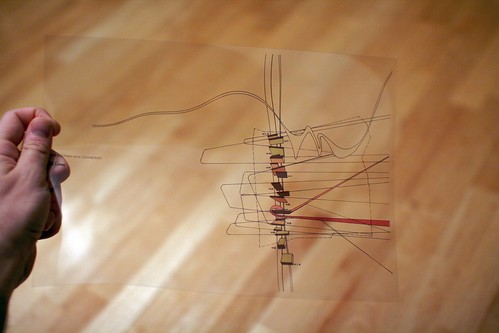 Received today my copy of You Are the City: Observation, Organization and Transformation of Urban Settings by Petra Kempf, definitely a gem in my collection of books and artifacts about urbanism. Made of 22 transparent slides in a folder, and a 16 page brochure, as described by the author:
Received today my copy of You Are the City: Observation, Organization and Transformation of Urban Settings by Petra Kempf, definitely a gem in my collection of books and artifacts about urbanism. Made of 22 transparent slides in a folder, and a 16 page brochure, as described by the author:
"this publication offers architects, urban planners and general readers interested in city design and growth a novel approach, a mapping tool that creates a framework for understanding the continually changing configuration of the city. With the aid of themed transparencies, the tool allows one to superimpose various realities in layers in order to create new urban connections, thus inviting readers to immerse themselves in the complexity of our cities."
Readers interested in Petra Kempf's work may be interested in this interview, from which I took the following excerpts:
"there are many ways to represent cities and each of the mapping technologies available certainly have their value and importance. However the technologies that are currently available, are mostly based on numbers and facts, not personal experiences. But to really experience a city one must be part of it. This is an analog process, by which we engage with a city’s intricate fabric. To re-create that analog process, in this project, I needed to use a tool that helped me simulate that experience. The limitations and computational restrictions of a computer program did not allow me that opportunity. (...) Mapping human flows in cities is a daunting task. I have mixed feelings about mapping these flows, since it could easily shift into ‘the big brother is watching or tracing’ the flows of people. Examples are already at hand with tracing people through their mobile phones, personal GPS security devices, ISP addresses, debit cards or passports. I think one needs to be very diligent with this subject. When I think of mapping human flows I think of Michel de Certeau or Henri Lefebvre, to name just two. They thought of the urban inhabitant as someone who could never be traced, since he/she always slips away from the ‘official’, traceable path. In this way each individual creates their own path, which can not be traced—even though they shape the city and the city shapes them."
Also about how cities have always been informed by the traces we leave here and there:

Why do I blog this? What I find intriguing with this "instrument" is that the transparent sheets enable readers to perceive the city by isolating and superimposing different urban components. Doing so, one build his or her own representation of what a City can be.
Beyond the author's purpose, these sheets remind me of Dan Hill and Andrew vande Moere's workshop exercices. As you may notice, it's perhaps the use of transparent and overlays that made me think about it. I like this project both for its aesthetics (and how it reshape the notion of maps) and as a methodology to observe and discuss about the urban fabric. The manipulation of transparent sheets (superimposing various versions) enable to trigger interesting conversations and I am pretty sure that the design of similar maps for a specific neighborhood can also be a curious tool in workshops.



